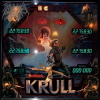Eternal Darkness: Sanity's Requiem (GameCube) review"Eternal Darkness (ED) arrived for the GameCube with a fearsome aura about it. In common with Resident Evil Zero, this horror opus was originally slated for release on the Nintendo 64, before that console's premature exit prompted ED's migration to the next console generation and its entering into an even more drawn out development period. When the game finally emerged, it commanded immediate awe from anxious GameCubers, who had heard that it was going to be the next killer app, yet..." |
Eternal Darkness (ED) arrived for the GameCube with a fearsome aura about it. In common with Resident Evil Zero, this horror opus was originally slated for release on the Nintendo 64, before that console's premature exit prompted ED's migration to the next console generation and its entering into an even more drawn out development period. When the game finally emerged, it commanded immediate awe from anxious GameCubers, who had heard that it was going to be the next killer app, yet who for the most part were still getting used to the idea of quality horror games being born on their console at all. The ED hype spoke of an action-adventure which would simulate hallucinations, boast an innovative magic system, and whose magnitude of plot and scale would be immense beyond anything seen in gaming before.
I wasn't immune to all of this advance scariness. The prospect of playing twelve characters across two millennia to combat a Cthulhu-like threat to humanity gave me the biggest case of pre-game excitement and anxiety I'd ever experienced. I was afraid the whole thing might prove to be too hard to play, too hard to follow, or just plain unmanageable and overwhelming.
To my great relief, ED turned out to be a game of vastly generous design. Consistently helpful and intuitive, it introduces its myriad elements in logical fashion, taking you into the embrace of a majestic horror adventure with grand plotting and themes, yet which is also transparently simple to play.
The darkness begins when cat-like heroine Alexandra Roivas returns to her family home in Rhode Island after the mysteriously gory death of her grandfather. Exploring the mansion, she discovers his hidden journal, which relates a startling tale of his research into a centuries old and ongoing battle between humans and an ancient evil force – the Eternal Darkness. Chapter pages of the diary open onscreen, with the sepia illustrations fading into animated life as the game. You will play through generations of individuals who have fought the darkness in turn, and bear witness as all their efforts and storylines build towards mighty consequences in the present.
This is one of the richest and most beautiful narrative designs I've seen in any game, and its scale felt genuinely new to me at the time as a creative possibility of 128-bit consoles. Locations are seen to change over centuries. Characters' actions and their consequences echo in memories and across time. Revelations and plot twists can shoot forwards and backwards. The game manages all of this, yet never loses sight of the fact that each chapter is about an individual, and that individual's often bleak story.
ED enforces the joys of playing a broad and unlikely range of characters, encouraging you to empathise with all their different physical qualities, both onscreen and via their responsiveness of control. Alex sprints about with a young woman's energy, but with her light frame she tires rapidly in a fight. Guiding Alex feels nothing like guiding a tottering overweight scholar armed with flintlock pistols, a bald middle-aged monk of deceptive strength, a lithe dancing girl whose bare feet can be heard slapping on the temple floors, a pudgy architect of the Renaissance, or an Errol Flynn-like prince. I once read a review of the game which joked about the need to play 'fat old men', but that need is part of the game's point, that the evil isn't fought by conspicuous heroes, but by a disparate group of frightened and often unwilling individuals.
A slew of zombies and demons threaten your protagonists across all historical periods. To cut them down you will have at your disposal the respective weapons of all those historical periods, from the blowguns, bastard swords and chakrams of the past, to the assault rifles and grenade launchers of the present. Combat is uncomplicated in execution, with an attack button, a combo for each character (often the same combo) and a targeting system which allows you to remove limbs and heads. There are sequences of deceptive difficulty in the game, but for the most part the battles aren't difficult. This doesn't mean that they're not engrossing or brilliantly portrayed, and it's hard not to feel your pulse rate rise as a horde of zombies closes in.
The alignment-based, magical and constitutional elements of the game are elegantly interwoven to create a coherent mythology. Red represents health, green sanity and blue magic, a system applied consistently across runes, spells, your characters' statistical makeup and the monster design. In a rock, scissors, paper fashion, each alignment or colour bests another. The strongly hyped concept of 'sanity' is ED's own. Being discovered by demons, or bearing witness to some of their more horrific behaviour (a bone thief erupting from a corpse's skull, for instance) or to other arcane events, drains player sanity. Heavy sanity loss results in increasingly severe hallucinations which are experienced in game as if they were real.
No game had tried anything like this prior to ED, and there are inherent difficulties in making certain surprises work more than once in a repeating system like a videogame, especially when the player can check his/her own sanity meter. But this doesn't detract from some fantastic, imaginative and often hilarious shocks which are likely to stop most players' hearts, nor from the general atmosphere which accompanies low sanity, that sick tilt on the graphics and the harrowing audio assault, which is always effecting.
The biggest flaw in the system is that the average player will find it easy to keep their sanity levels in the safe zone with just a little diligence, by 'finishing' any downed monsters. And without the insanity assaults, ED proves to be a strategically gentle game. There are almost no hardcore action sequences that demand the use of a particular weapon, spell, or precise placement or planning. On the one hand, this invites a great freedom, and it's fun to experiment with all of your spells and weapons once your basic skill level in the game is sufficient to dispatch different configurations of zombies, horrors and bonethieves. On the other hand, there is no mounting sense of combat danger or strategy in the late end of the game. It's just 'more of what you killed before.'
There was also some player complaint upon the game's release of ED's puzzles being too simple and repetitive. It's true that ultimately I never had to make a map or note down clues to keep progressing through the game, and that I was able to hold it all in my head at one time – which was the very thing I had been afraid I would be unable to do. But the formal qualities of ritual and repetition are crucial to the meaning in ED. To visit the same church as three different characters in three different time periods and for three different purposes, for instance, makes you aware of the echoes of the actions of individuals in time, and of the historical memory gathered by a location, and even suggests a weird vestigial memory that spans time ('You' the player have been here before, but 'you' the character have not.) ED creates the supernatural sense that people related by blood or cause will unconsciously repeat each other's actions through time. The idea of a collective unconsciousness is not too alien to most of us, and it's even mentioned in the game's dialogue at one point, as is synchronicity, but for a game to tap into these abstract concepts and give the player a lived sense of them, as ED does with its persistent take on deja vu, is a very impressive feat.
Playing Eternal Darkness produces a sad resonance that arises from seeing the daily struggles and hopes of individuals placed in the context of greater passing time and mortality. The Cambodian slave/dancing girl Ellia dreams that her small life might open onto some excitement or higher purpose, and suddenly finds her wishes granted at great cost. A monk's faith is tested when he finds corruption in the holy order. A page's loyalty to his lord has tragic consequences only for himself. A Persian prince's lust for a princess sends him on a fool's errand, and so on.
ED is thus a horror adventure about the brave and sometimes wasteful ends of the lives of good people, temporal futility and the unforeseeable echoes of the actions of individuals. Not all of the characters are related or could even have imagined or dreamed of each other's existence in different ages, but they all play their part in events which ultimately lead to one moment. The game emphasises the connections by flashing up an ever-lengthening blast of images from the stories of characters you've already played each time you enter a new chapter, and you can feel the cumulative meaning of all their actions – and in some cases, their deaths – gathering like a weight.
That the game achieves this gravity is its great accomplishment, far more important than its occasional over-easiness or repetitiveness of combat. It also demonstrates a formidable amount of historical research. The rich variety of costuming, architecture and social customs, and their placement in the context of historical events and situations across multiple time periods, is remarkable. This was another aspect of ED whose degree struck me as unprecedented, for an action-adventure game, when the title was first released in 2002.
ED's newness lay above all in its ambitious narrative scale, and secondarily in its attempts to figure distortions of perception into game mechanics through the sanity meter and effects. If you can't trust what your senses feed you, what can you trust? ED delivers this idea as a series of shock-horror tricks that will certainly frighten you, and just as often make you squirm with relief, delight or laughter when you realise you've been fooled, but the discretion and low repeatability of these tricks is limiting, and it's too easy to maintain your sanity. I'm not aware of any later game which tried to build on ED's sanity model, and that's probably because it's just too flawed. Nevertheless, it presents boldly for its single outing.
Even as I write this, eight years after ED's arrival, the game remains unique in scale as something like the Gone With The Wind of survival horror games. With its many player characters working together across a range of time zones and historical settings, its spiderweb of a grand narrative and its butterfly effect like sense of causality, it is undoubtedly one of the best stories told in videogaming. The game's evocation of the mysteries of time is fascinating, eerie and inspiring. There's a lot of bravery and sacrifice on display (as opposed to the more typical survival horror motive of self preservation) and while a lot of characters face a lot of grim ends, the ultimate sense of the game is one of optimism. ED gives you the feeling that even in the grander scheme of history, you as an individual may have an important role to play as you live today.
 |  |  |  |  |
Community review by bloomer (January 13, 2010)
A bio for this contributor is currently unavailable, but check back soon to see if that changes. If you are the author of this review, you can update your bio from the Settings page. |
|
More Reviews by bloomer [+]
|
|
If you enjoyed this Eternal Darkness: Sanity's Requiem review, you're encouraged to discuss it with the author and with other members of the site's community. If you don't already have an HonestGamers account, you can sign up for one in a snap. Thank you for reading!
User Help | Contact | Ethics | Sponsor Guide | Links













